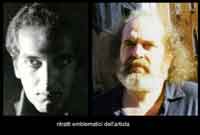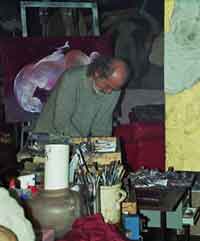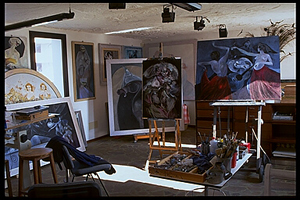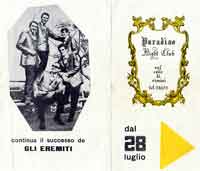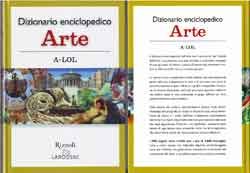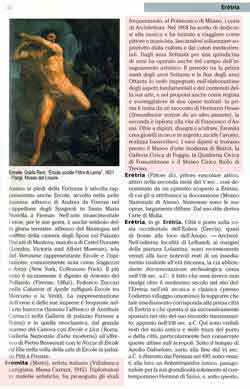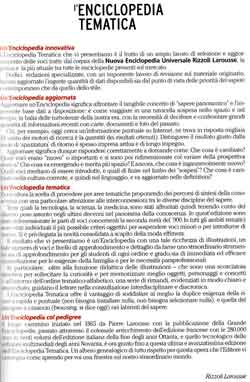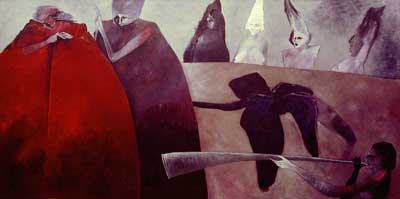 2 august 1980 diptych part I |
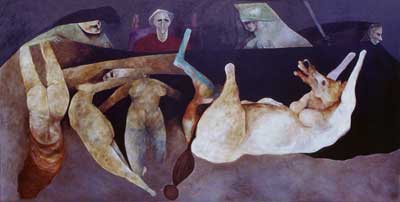 2 august 1980 diptych part II |

This is the biography of the Artist Mario Eremita, clearly apologetic, partial and subjectivea.
Otherwise, how can be a biography impartial and objective?
Who writes it will always give prominence to the one that will serve the idea that has arisen. The idea of this biography is to record faithfully the life of the Artist. The point of view is that of someone who has lived with him for more tha forty years. Maybe, even though the apologetic intention, it will be the most authoritative biography you will find.
Mario Eremita is born on 18 October 1942 in Villafranca Lunigiana in the Italian province of Massa Carrara ( Toscana ).
Shortly after the birth of Mario, the family moves to the Region of Romagna: first at Sant'Arcangelo and then at Rimini, a town where the artist will spend the first part of his life: childhood, boyhood and adolescence.
Mario Eremita was a child with the special skill of manual ability; Was a boy precociously able to master the techniques of figurative arts and music. Today he loves to remember his boyhood full of afternoons spent with his uncle Antonio painting “en plein air”, along the Rimini’s seafront among the malatestian’s ruins.
Before the age of fifteen he produced a great an admirable collection of drawings in gouache on paper, some of which are still preserved. Observing these drawings you see a singular expressive force and a capacity for observation that are typical only of genius.
During the boyhood Mario Eremita developed his particular love for images, forms and colours of world. Today he likes to recall all the memories about contemplation: those were times he was charmed by all the works of nature but especially by works of humanity.
His sensitiveness his soft and original. Of course this aspect will clash with an oppressive and limited context that was the italian reality of those times.
It is the italian reality of the early sixties, backward, bourgeois, provincial; or ideological and full of prejudices, ignorance, narrow-mindedness; far away from the Italian magnificence of Renaissance, of Humanism.
It is an Italy that has difficulty to recover from war. It is an Italy that will never more have the role of beacon of culture and art compared to the rest of the world and in particular the United States of which it will become silent servant.
Afterwards it will be difficult also his relation with school. Mario Eremita considers the school the centerpiece of the society and the only possible hope of rebirth and moral and intellectual development of the country. Mario Eremita rejected the authoritative background of the school of that times, because this method was absolutely not able to encourage, appreciate and motivate the expression of his particular personality and his innate skills
It will be a costant factor into the Eremita’s art contents the disapproval of school’s authoritarianism and of the lack of authoritativeness that make school a place unfit to the human’s fulfilment. So, his art will be based on Human Condition.
Who knows, Chissà, has been the influence of Tonino Guerra, who attended the family and held him in her arms, has been the influence of Romagna, the dreamy world but with feet firmly planted on the ground, which gave birth to the genius of Federico Fellini; has been this heavy controversy, built from an early age, to the institutions that should form the individual; so much so that Eremita was absorbed by the relentless love for the depiction of the Human Condition
During the adolescence Mario Eremita had a short political experience into the Communist Party; but it rudely broke off when he noticed that ideas and ideals did not put at the centre the humanity but they were only some dialectical tricks to hide mediocrity, not disinterested actions, thirst of power, all based on a growing uncontrollable violence.
Now already sufficiently disgusted; but still young man full of resources, Eremita complies with his music’s skill. Charmed by that art he travelled all over the world as solo voice. He founded his own band called “Gli Eremiti” earning success in the lively Riviera Romagnola in the sixties. He get in touch with many celebrities in those years among them Mina and Fred Buscaglione; but he remains elusive and he renounces the possible opportunities to "break".
Then Eremita take up the study of architecture at the Milan Polytechnic. Nevertheless he is disenchanted. The student protest began in 1968 in Italy also. This aspects of the italian culture and politics of the end of sixties will drive art to be subordinate to ideological intellectualisms detached from reality. Eremita, seconding the Pier Paolo Pasolini’s opinion, preferred the ancient ideals of Renaissance and Humanism of italian arts to the sterile protest and to the destructive intentions of a “develop without progress”. So he dedicated his art to the ancient traditions of great italian and flemish painting. His profession of artist will be the same as his life
Of the latter years of the "sixties" are the first expressionist works, mixed media oil and sea sand drawings and mixed media.
Painting and sculpture became the centre and the reason of his life, because art is his vision of reality, his weltanschauung. He rejects what he thinks is a bluff: the content that dominates form
He thinks that it cannot exist any content if the artist has not lie dormant his experience elaborating techniques; if the artist has not put his skills to the test; but not only. He thinks that the naif artist, or the artist wihtout any culture and fallen a prey to instincts, or the artist without manual skills only driven to the urgency of content, reduced to be a so-called “militant artist”, is decadent and useless.
Art is the way of life for Eremita. Music is the media to keep in touch with world, painting and sculpture is the way to testify his sensitive inner life. Eremita spent a busy period of work in Lebanon. The culture and warm colours of the Middle East immediately inspired and enriched Eremita’s creativity, at the same time leaving an indelible mark on his artistic expression. Signs of this contamination are evident into all his works, both the form and the content
Those places, with strong social differences, exacerbate the sensitivity of the artist for the Human Condition in which the more he testifies in his works.
Meaningful charcoal drawings dedicated to the Lebanese children, testifying to the difficult conditions in which they lived, next to a scathing and shameless display of wealth of the West.
Seized a good opportunity in the field of music, Eremita moves to England, where he has the opportunity to experience these dynamic and challenging environments in the world of contemporary art and music.
He is restless and maybe he has nostalgia for his homeland. So he returns in Italy and meets Miss. Rinalda Truffi, the woman who will become his wife. She will help him for public relations, devoting to it much of hers professional life.
while continuing his work as an artist, Mario Eremita decides to pursue a career as teacher and returning to the world that, in the past, had assumed negative and hostile. His intention is to contribute with his experience of life, the education of young people. So he devote himself to the teaching of Design and Art History
Nevertheless he notices that the italian school has serious shortcomings which hamper learning and maturation of students. The artist set himself against that detrimental ambient driven by his moral strength
He fashioned a special bond with his students, thanks to his unique cultural background and his instinctive openness to new experiences aimed at developing independent thought. Eremita, using his skills, introduced innovative teaching method, based on self-responsibility, manuality, the team game, the prizegiving to pragmatic attitudes
All of that, as it is for the music, is poured into the primary speculation: the figurative art. The Eremita’s great imagination and the huge gift of the ability to be concise and to observe, is broaden into an ingenious kind of subjects when he comes in contact with the school’s ambient. The satire becomes one of his preferred themes. His art, life and weltanschauung of Eremita are the same thing.
This is the environment which saw the growth and strengthening of the basic features of Eremita’s painting and sculpture: the Human Condition’s Theme. This wide content was primed in the inner nature of this artist.
The profession of a teacher is a long period of Eremita’s art activity. The role he assumed with great authoritativeness and humanity, ripens the artist and makes him an effective interpreter of human vicissitude.
Eremita forty-year-old man in the full ripeness introduced his own painting style absolutely free from any movement of art. His painting is born free from any patronage or political conditioning; free from ideological or partial visions. Eremita makes his own art as an existential need, as the duty to testify, at first to himself then to the world. In that sense his art is an ascetic practice, it has an apotropaic and liberating function.
He creates a collection of paintings on canvas of unprecedented power. Strong works of perfect technique, a total mastery of color and compelling motivation in content. The entire collection will be on display in an exhibition at Cà da Noal in Treviso in 1978, which will become most visited after that of Gino Rossi, the great master of Venetian painting of the early twentieth century.
On the occasion of this important exhibition, one of the most significant titles are: "human condition unworthy of man"; "initiation of violence"; "tribute to that woodworm that they call thought"
Eremita’s works are suited to wide reading both techical-formal and cultural-content point of view. In fact every work is such as an ethical outline enriched with lacerating and desecrating provocations and powerful ironical and sarcastic aspects. His works are likened to literature and music because of theirs quality and deepness of content and form.
They represent our world, but they do it again in a distorted way through the eyes of truth relentless and irreverent, ironic and revealing. The artist, in this sense, retrieves his role.
At the high point in his experience as a schoolteacher, Eremita writes and directs two works for the theatre. The first is based on a Hermann Hesse story entitled “Astonishing News from Another Planet”; the second on the life of Saint Francis of Assisi. The students themselves stage these productions. Both works are performed in the Municipal Theatre and the Church of San Francesco in Treviso. Toward the end of the 1980s, Eremita leaves teaching in order to devote himself completely to his art.
he wideness of his work is testified from the talent to deal with different techniques. As Federico Zeri said: “There are no minor arts but there is only the profession of artist and the life lived as an artist”.
In 1990 it started the collaboration with his two sons Nicola and Michelangelo. Nicola deals with business and criticism whereas Michelangelo follows father’s footsteps. They founded on 2001 the Art Gallery III Millennio that will mainly deal with Mario Eremita but also will host undred of artists from all over the world.
They create a small art workshop inspired by the antique shops of the Italian Renaissance. Mario Eremita turns his excited imagination even to the precious metals, and within 30 years he creates tens of thousands of works of graphic art, sculpture, painting, printmaking
Most of those works are sold in a particular market to individual enthusiasts collectors, and institutions of public and private companies. This happens with the most total indifference of Art Galleries, the auction houses, and the Foundations of all the institutions that formally deal of Contemporary Art.
In 1992, he salutes the city Treviso with the exhibition at "Casa dei Carraresi" where he exposes the diptych "2agosto1980", dedicated to the massacre at the railway station of Bologna, 1980 "Italian Guernica".
Eremita like many others like him, experiences the anachronism of its artistic dimension. He faces the presence of a granitic indifference of those who claim to be communicators in the world of arts and dealing in particular of Contemporary Art, relying on their role. Responsibilities have to be identified on the many who have not been able or willing to see and barricaded themselves in their cowardice
Nicola and Michelangelo are aware of the harsh nature of the "culture" of the arts but also of the great talents of theirs father and of themselves. So they founded in 2001 the Third Millennium Art Gallery which will mainly focus on Mario Eremita but that will expand soon its activity exhibition with hundreds of other Italian and foreign artists, giving many young artists the opportunity to deal with the public display of their works.
His paintings can be found at the Museum of Modern Art in Beirut, the City Gallery in Foggia, the "Cesarini"’s picture gallery of Fossombrone and the “Bailo” City Museum in Treviso, the National Art Gallery of Sofia in Bulgary.
The artist's works are cited among the cultural heritage of the Marche Region.
From 2005 Mario Eremita is into the Rizzoli Larousse’s Encyclopaedia “Art”.
Artist's works are in the possession of collectors and personality public around the world.
Today the artist lives and works in Venezia.



